The Controversial World of Nude Paintings in Early Canadian Art
VerifiedAdded on 2022/08/20
|9
|2821
|12
Essay
AI Summary
This essay delves into the contentious history of nude paintings in early Canadian art, focusing on the challenges artists faced due to censorship and societal norms during the early twentieth century. It examines the historical dominance of landscape painting, particularly the influence of the Group of Seven, which overshadowed themes related to the human figure. The essay highlights how artists like John Lyman, Bertram Brooker, and Lilias Torrance Newton, were criticized and faced restrictions on exhibiting their works. It also discusses the controversial reactions to artists such as Prudence Heward and Dorothy Stevens' depictions of nude figures, particularly Black women, and how these works challenged conventional representations and sparked debates about morality, sexuality, and racial biases within the art world. Furthermore, the essay analyzes how nude portrayals failed to fit within the dominant landscape painting genre and discusses how artists sought to explore the relationship between the artist, model, and viewer. The essay concludes by emphasizing the dynamic interplay of social impressions, discrimination, and the impact of modernism on the development of Canadian art, illustrating the complexities of the nude as a subject in early Canadian art history.

Running head: EARLY CANADIAN ART
EARLY CANADIAN ART
Name of the Student:
Name of the University:
Author note:
EARLY CANADIAN ART
Name of the Student:
Name of the University:
Author note:
Paraphrase This Document
Need a fresh take? Get an instant paraphrase of this document with our AI Paraphraser
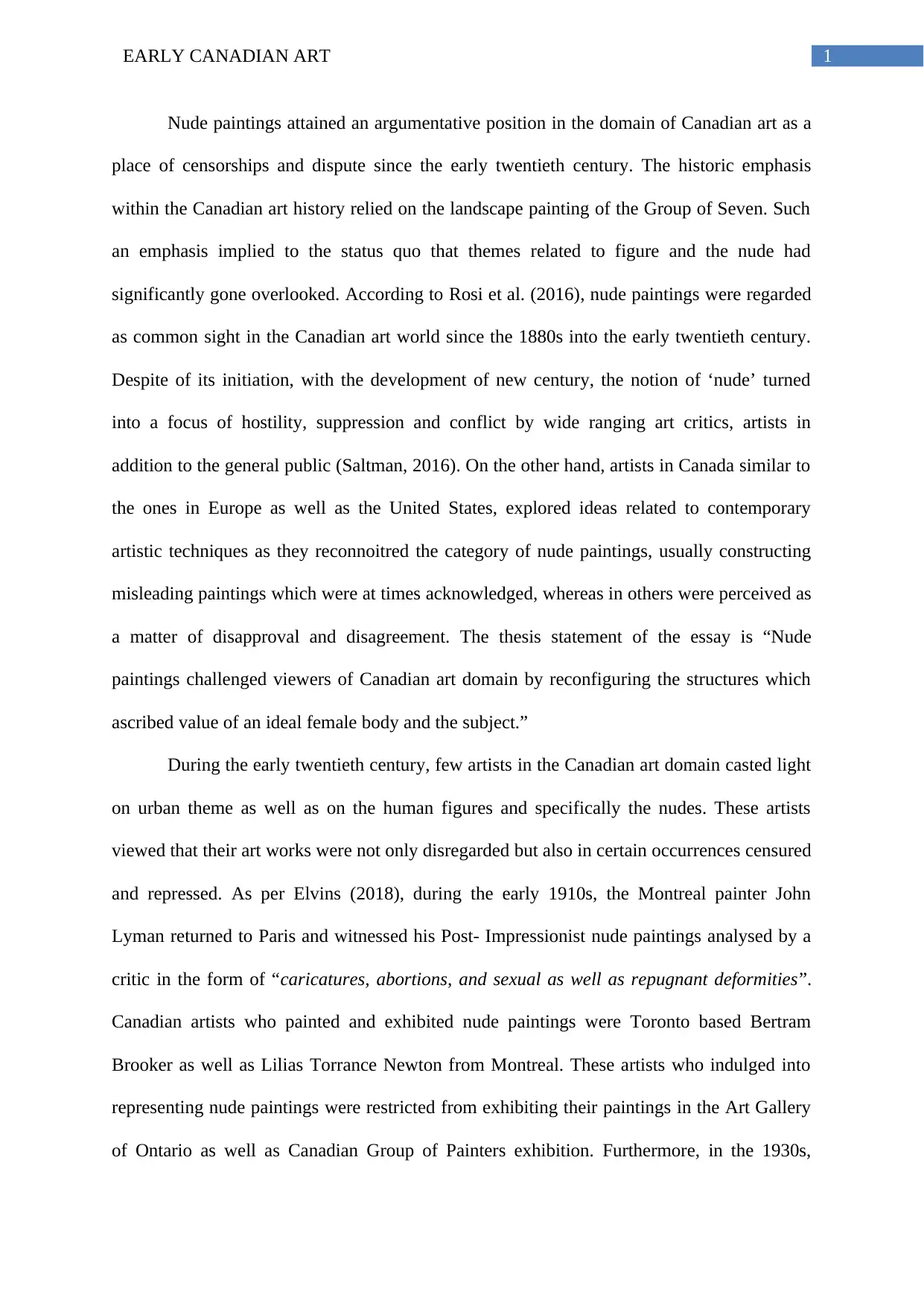
1EARLY CANADIAN ART
Nude paintings attained an argumentative position in the domain of Canadian art as a
place of censorships and dispute since the early twentieth century. The historic emphasis
within the Canadian art history relied on the landscape painting of the Group of Seven. Such
an emphasis implied to the status quo that themes related to figure and the nude had
significantly gone overlooked. According to Rosi et al. (2016), nude paintings were regarded
as common sight in the Canadian art world since the 1880s into the early twentieth century.
Despite of its initiation, with the development of new century, the notion of ‘nude’ turned
into a focus of hostility, suppression and conflict by wide ranging art critics, artists in
addition to the general public (Saltman, 2016). On the other hand, artists in Canada similar to
the ones in Europe as well as the United States, explored ideas related to contemporary
artistic techniques as they reconnoitred the category of nude paintings, usually constructing
misleading paintings which were at times acknowledged, whereas in others were perceived as
a matter of disapproval and disagreement. The thesis statement of the essay is “Nude
paintings challenged viewers of Canadian art domain by reconfiguring the structures which
ascribed value of an ideal female body and the subject.”
During the early twentieth century, few artists in the Canadian art domain casted light
on urban theme as well as on the human figures and specifically the nudes. These artists
viewed that their art works were not only disregarded but also in certain occurrences censured
and repressed. As per Elvins (2018), during the early 1910s, the Montreal painter John
Lyman returned to Paris and witnessed his Post- Impressionist nude paintings analysed by a
critic in the form of “caricatures, abortions, and sexual as well as repugnant deformities”.
Canadian artists who painted and exhibited nude paintings were Toronto based Bertram
Brooker as well as Lilias Torrance Newton from Montreal. These artists who indulged into
representing nude paintings were restricted from exhibiting their paintings in the Art Gallery
of Ontario as well as Canadian Group of Painters exhibition. Furthermore, in the 1930s,
Nude paintings attained an argumentative position in the domain of Canadian art as a
place of censorships and dispute since the early twentieth century. The historic emphasis
within the Canadian art history relied on the landscape painting of the Group of Seven. Such
an emphasis implied to the status quo that themes related to figure and the nude had
significantly gone overlooked. According to Rosi et al. (2016), nude paintings were regarded
as common sight in the Canadian art world since the 1880s into the early twentieth century.
Despite of its initiation, with the development of new century, the notion of ‘nude’ turned
into a focus of hostility, suppression and conflict by wide ranging art critics, artists in
addition to the general public (Saltman, 2016). On the other hand, artists in Canada similar to
the ones in Europe as well as the United States, explored ideas related to contemporary
artistic techniques as they reconnoitred the category of nude paintings, usually constructing
misleading paintings which were at times acknowledged, whereas in others were perceived as
a matter of disapproval and disagreement. The thesis statement of the essay is “Nude
paintings challenged viewers of Canadian art domain by reconfiguring the structures which
ascribed value of an ideal female body and the subject.”
During the early twentieth century, few artists in the Canadian art domain casted light
on urban theme as well as on the human figures and specifically the nudes. These artists
viewed that their art works were not only disregarded but also in certain occurrences censured
and repressed. As per Elvins (2018), during the early 1910s, the Montreal painter John
Lyman returned to Paris and witnessed his Post- Impressionist nude paintings analysed by a
critic in the form of “caricatures, abortions, and sexual as well as repugnant deformities”.
Canadian artists who painted and exhibited nude paintings were Toronto based Bertram
Brooker as well as Lilias Torrance Newton from Montreal. These artists who indulged into
representing nude paintings were restricted from exhibiting their paintings in the Art Gallery
of Ontario as well as Canadian Group of Painters exhibition. Furthermore, in the 1930s,
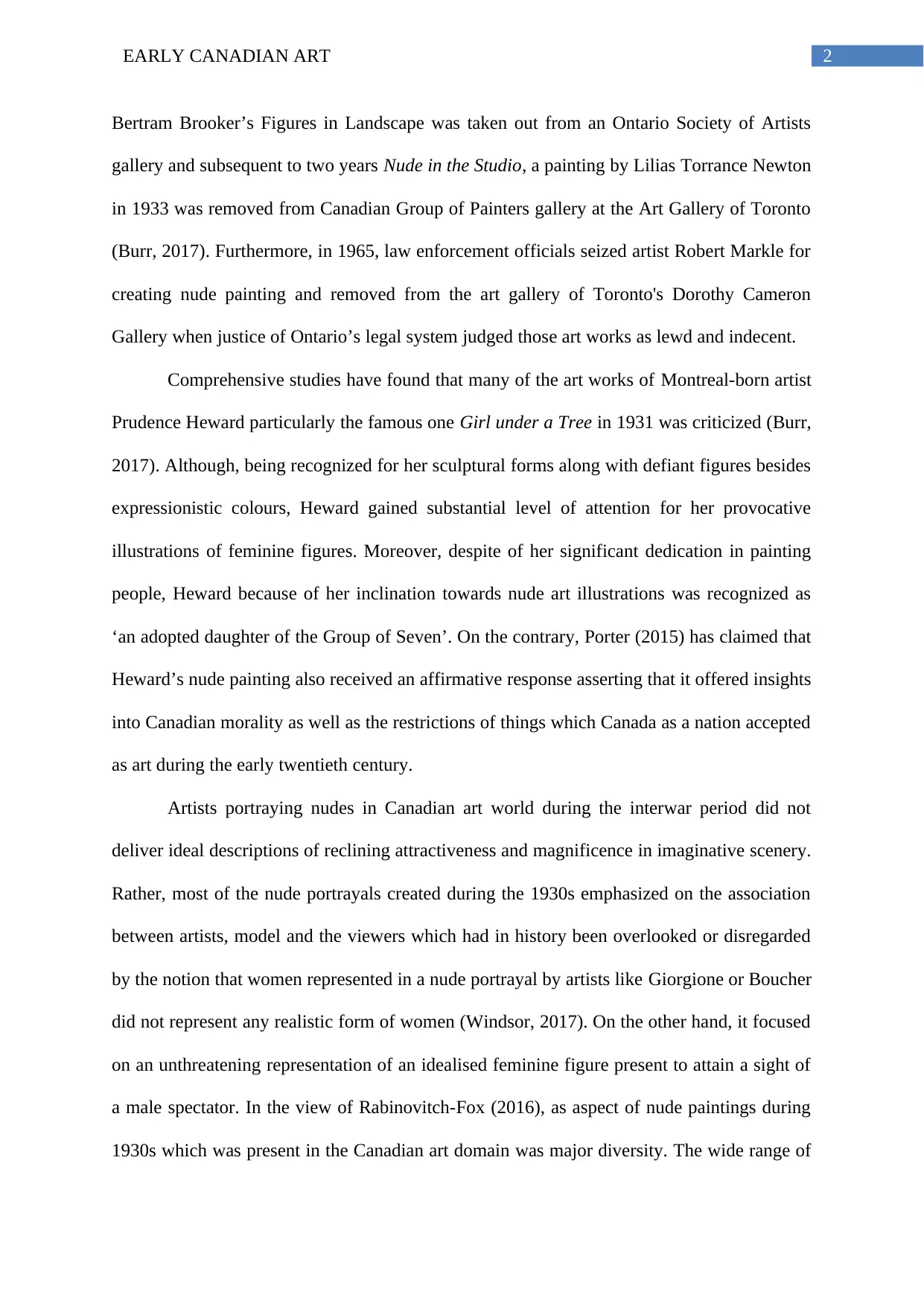
2EARLY CANADIAN ART
Bertram Brooker’s Figures in Landscape was taken out from an Ontario Society of Artists
gallery and subsequent to two years Nude in the Studio, a painting by Lilias Torrance Newton
in 1933 was removed from Canadian Group of Painters gallery at the Art Gallery of Toronto
(Burr, 2017). Furthermore, in 1965, law enforcement officials seized artist Robert Markle for
creating nude painting and removed from the art gallery of Toronto's Dorothy Cameron
Gallery when justice of Ontario’s legal system judged those art works as lewd and indecent.
Comprehensive studies have found that many of the art works of Montreal-born artist
Prudence Heward particularly the famous one Girl under a Tree in 1931 was criticized (Burr,
2017). Although, being recognized for her sculptural forms along with defiant figures besides
expressionistic colours, Heward gained substantial level of attention for her provocative
illustrations of feminine figures. Moreover, despite of her significant dedication in painting
people, Heward because of her inclination towards nude art illustrations was recognized as
‘an adopted daughter of the Group of Seven’. On the contrary, Porter (2015) has claimed that
Heward’s nude painting also received an affirmative response asserting that it offered insights
into Canadian morality as well as the restrictions of things which Canada as a nation accepted
as art during the early twentieth century.
Artists portraying nudes in Canadian art world during the interwar period did not
deliver ideal descriptions of reclining attractiveness and magnificence in imaginative scenery.
Rather, most of the nude portrayals created during the 1930s emphasized on the association
between artists, model and the viewers which had in history been overlooked or disregarded
by the notion that women represented in a nude portrayal by artists like Giorgione or Boucher
did not represent any realistic form of women (Windsor, 2017). On the other hand, it focused
on an unthreatening representation of an idealised feminine figure present to attain a sight of
a male spectator. In the view of Rabinovitch-Fox (2016), as aspect of nude paintings during
1930s which was present in the Canadian art domain was major diversity. The wide range of
Bertram Brooker’s Figures in Landscape was taken out from an Ontario Society of Artists
gallery and subsequent to two years Nude in the Studio, a painting by Lilias Torrance Newton
in 1933 was removed from Canadian Group of Painters gallery at the Art Gallery of Toronto
(Burr, 2017). Furthermore, in 1965, law enforcement officials seized artist Robert Markle for
creating nude painting and removed from the art gallery of Toronto's Dorothy Cameron
Gallery when justice of Ontario’s legal system judged those art works as lewd and indecent.
Comprehensive studies have found that many of the art works of Montreal-born artist
Prudence Heward particularly the famous one Girl under a Tree in 1931 was criticized (Burr,
2017). Although, being recognized for her sculptural forms along with defiant figures besides
expressionistic colours, Heward gained substantial level of attention for her provocative
illustrations of feminine figures. Moreover, despite of her significant dedication in painting
people, Heward because of her inclination towards nude art illustrations was recognized as
‘an adopted daughter of the Group of Seven’. On the contrary, Porter (2015) has claimed that
Heward’s nude painting also received an affirmative response asserting that it offered insights
into Canadian morality as well as the restrictions of things which Canada as a nation accepted
as art during the early twentieth century.
Artists portraying nudes in Canadian art world during the interwar period did not
deliver ideal descriptions of reclining attractiveness and magnificence in imaginative scenery.
Rather, most of the nude portrayals created during the 1930s emphasized on the association
between artists, model and the viewers which had in history been overlooked or disregarded
by the notion that women represented in a nude portrayal by artists like Giorgione or Boucher
did not represent any realistic form of women (Windsor, 2017). On the other hand, it focused
on an unthreatening representation of an idealised feminine figure present to attain a sight of
a male spectator. In the view of Rabinovitch-Fox (2016), as aspect of nude paintings during
1930s which was present in the Canadian art domain was major diversity. The wide range of
⊘ This is a preview!⊘
Do you want full access?
Subscribe today to unlock all pages.

Trusted by 1+ million students worldwide
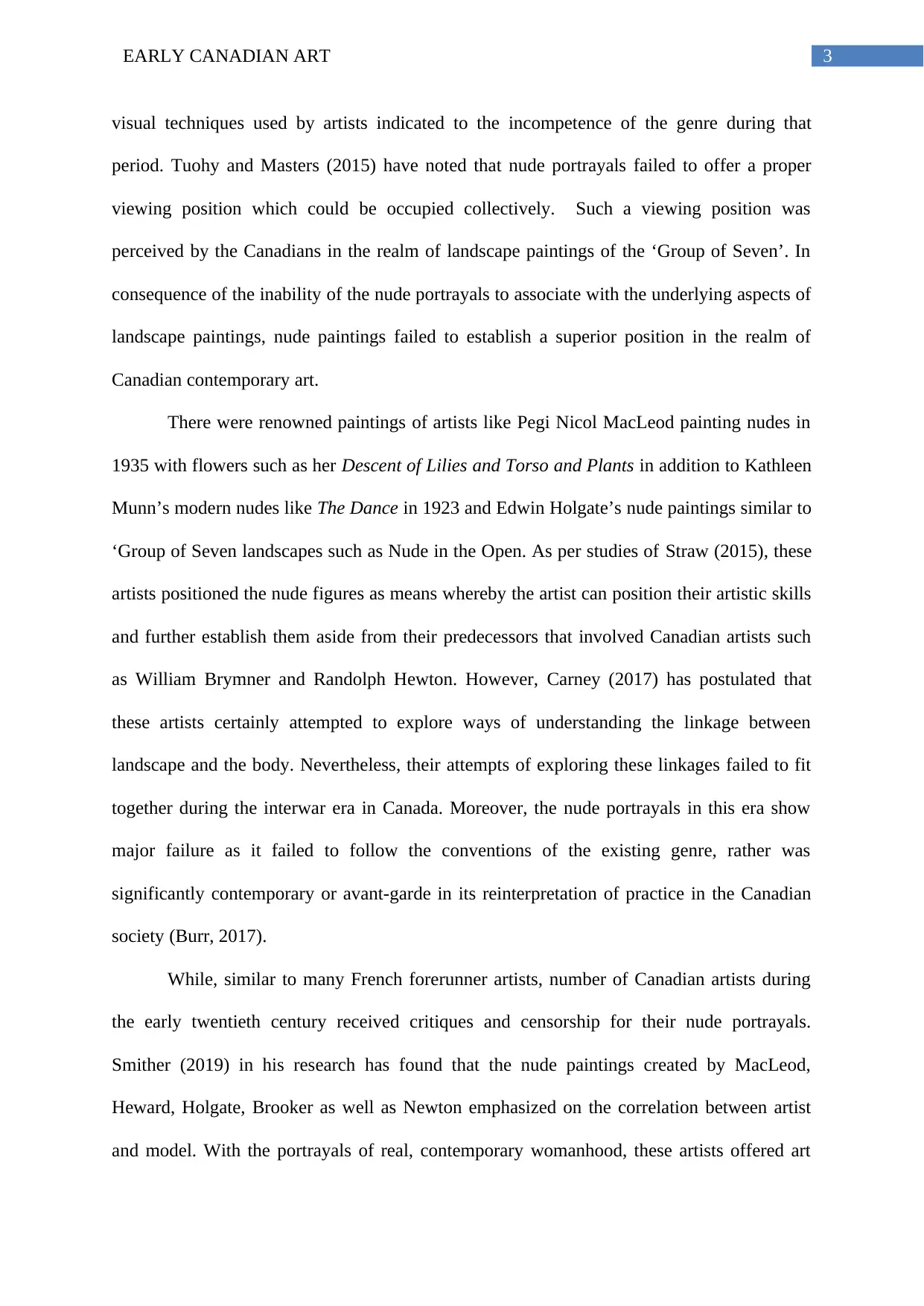
3EARLY CANADIAN ART
visual techniques used by artists indicated to the incompetence of the genre during that
period. Tuohy and Masters (2015) have noted that nude portrayals failed to offer a proper
viewing position which could be occupied collectively. Such a viewing position was
perceived by the Canadians in the realm of landscape paintings of the ‘Group of Seven’. In
consequence of the inability of the nude portrayals to associate with the underlying aspects of
landscape paintings, nude paintings failed to establish a superior position in the realm of
Canadian contemporary art.
There were renowned paintings of artists like Pegi Nicol MacLeod painting nudes in
1935 with flowers such as her Descent of Lilies and Torso and Plants in addition to Kathleen
Munn’s modern nudes like The Dance in 1923 and Edwin Holgate’s nude paintings similar to
‘Group of Seven landscapes such as Nude in the Open. As per studies of Straw (2015), these
artists positioned the nude figures as means whereby the artist can position their artistic skills
and further establish them aside from their predecessors that involved Canadian artists such
as William Brymner and Randolph Hewton. However, Carney (2017) has postulated that
these artists certainly attempted to explore ways of understanding the linkage between
landscape and the body. Nevertheless, their attempts of exploring these linkages failed to fit
together during the interwar era in Canada. Moreover, the nude portrayals in this era show
major failure as it failed to follow the conventions of the existing genre, rather was
significantly contemporary or avant-garde in its reinterpretation of practice in the Canadian
society (Burr, 2017).
While, similar to many French forerunner artists, number of Canadian artists during
the early twentieth century received critiques and censorship for their nude portrayals.
Smither (2019) in his research has found that the nude paintings created by MacLeod,
Heward, Holgate, Brooker as well as Newton emphasized on the correlation between artist
and model. With the portrayals of real, contemporary womanhood, these artists offered art
visual techniques used by artists indicated to the incompetence of the genre during that
period. Tuohy and Masters (2015) have noted that nude portrayals failed to offer a proper
viewing position which could be occupied collectively. Such a viewing position was
perceived by the Canadians in the realm of landscape paintings of the ‘Group of Seven’. In
consequence of the inability of the nude portrayals to associate with the underlying aspects of
landscape paintings, nude paintings failed to establish a superior position in the realm of
Canadian contemporary art.
There were renowned paintings of artists like Pegi Nicol MacLeod painting nudes in
1935 with flowers such as her Descent of Lilies and Torso and Plants in addition to Kathleen
Munn’s modern nudes like The Dance in 1923 and Edwin Holgate’s nude paintings similar to
‘Group of Seven landscapes such as Nude in the Open. As per studies of Straw (2015), these
artists positioned the nude figures as means whereby the artist can position their artistic skills
and further establish them aside from their predecessors that involved Canadian artists such
as William Brymner and Randolph Hewton. However, Carney (2017) has postulated that
these artists certainly attempted to explore ways of understanding the linkage between
landscape and the body. Nevertheless, their attempts of exploring these linkages failed to fit
together during the interwar era in Canada. Moreover, the nude portrayals in this era show
major failure as it failed to follow the conventions of the existing genre, rather was
significantly contemporary or avant-garde in its reinterpretation of practice in the Canadian
society (Burr, 2017).
While, similar to many French forerunner artists, number of Canadian artists during
the early twentieth century received critiques and censorship for their nude portrayals.
Smither (2019) in his research has found that the nude paintings created by MacLeod,
Heward, Holgate, Brooker as well as Newton emphasized on the correlation between artist
and model. With the portrayals of real, contemporary womanhood, these artists offered art
Paraphrase This Document
Need a fresh take? Get an instant paraphrase of this document with our AI Paraphraser
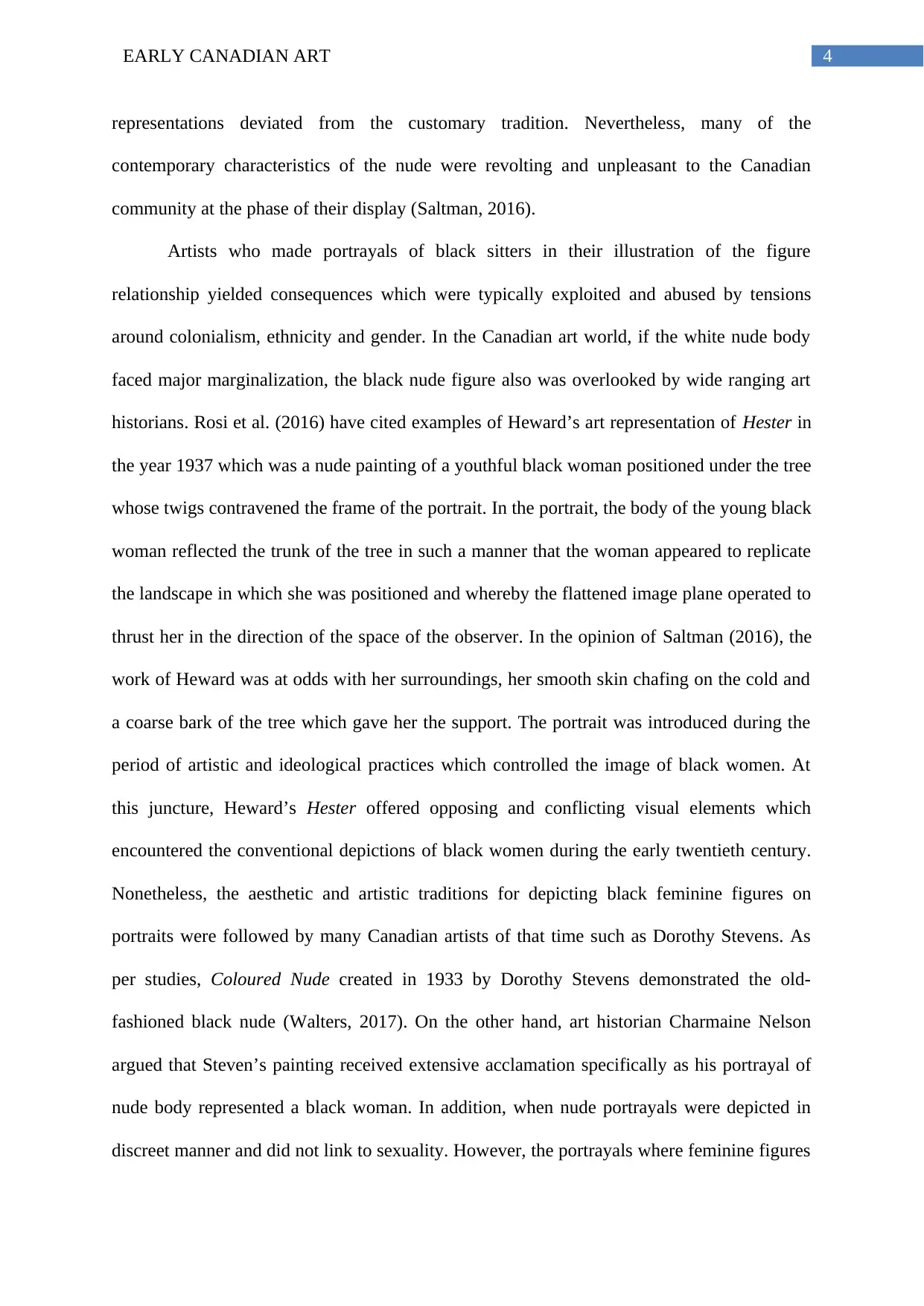
4EARLY CANADIAN ART
representations deviated from the customary tradition. Nevertheless, many of the
contemporary characteristics of the nude were revolting and unpleasant to the Canadian
community at the phase of their display (Saltman, 2016).
Artists who made portrayals of black sitters in their illustration of the figure
relationship yielded consequences which were typically exploited and abused by tensions
around colonialism, ethnicity and gender. In the Canadian art world, if the white nude body
faced major marginalization, the black nude figure also was overlooked by wide ranging art
historians. Rosi et al. (2016) have cited examples of Heward’s art representation of Hester in
the year 1937 which was a nude painting of a youthful black woman positioned under the tree
whose twigs contravened the frame of the portrait. In the portrait, the body of the young black
woman reflected the trunk of the tree in such a manner that the woman appeared to replicate
the landscape in which she was positioned and whereby the flattened image plane operated to
thrust her in the direction of the space of the observer. In the opinion of Saltman (2016), the
work of Heward was at odds with her surroundings, her smooth skin chafing on the cold and
a coarse bark of the tree which gave her the support. The portrait was introduced during the
period of artistic and ideological practices which controlled the image of black women. At
this juncture, Heward’s Hester offered opposing and conflicting visual elements which
encountered the conventional depictions of black women during the early twentieth century.
Nonetheless, the aesthetic and artistic traditions for depicting black feminine figures on
portraits were followed by many Canadian artists of that time such as Dorothy Stevens. As
per studies, Coloured Nude created in 1933 by Dorothy Stevens demonstrated the old-
fashioned black nude (Walters, 2017). On the other hand, art historian Charmaine Nelson
argued that Steven’s painting received extensive acclamation specifically as his portrayal of
nude body represented a black woman. In addition, when nude portrayals were depicted in
discreet manner and did not link to sexuality. However, the portrayals where feminine figures
representations deviated from the customary tradition. Nevertheless, many of the
contemporary characteristics of the nude were revolting and unpleasant to the Canadian
community at the phase of their display (Saltman, 2016).
Artists who made portrayals of black sitters in their illustration of the figure
relationship yielded consequences which were typically exploited and abused by tensions
around colonialism, ethnicity and gender. In the Canadian art world, if the white nude body
faced major marginalization, the black nude figure also was overlooked by wide ranging art
historians. Rosi et al. (2016) have cited examples of Heward’s art representation of Hester in
the year 1937 which was a nude painting of a youthful black woman positioned under the tree
whose twigs contravened the frame of the portrait. In the portrait, the body of the young black
woman reflected the trunk of the tree in such a manner that the woman appeared to replicate
the landscape in which she was positioned and whereby the flattened image plane operated to
thrust her in the direction of the space of the observer. In the opinion of Saltman (2016), the
work of Heward was at odds with her surroundings, her smooth skin chafing on the cold and
a coarse bark of the tree which gave her the support. The portrait was introduced during the
period of artistic and ideological practices which controlled the image of black women. At
this juncture, Heward’s Hester offered opposing and conflicting visual elements which
encountered the conventional depictions of black women during the early twentieth century.
Nonetheless, the aesthetic and artistic traditions for depicting black feminine figures on
portraits were followed by many Canadian artists of that time such as Dorothy Stevens. As
per studies, Coloured Nude created in 1933 by Dorothy Stevens demonstrated the old-
fashioned black nude (Walters, 2017). On the other hand, art historian Charmaine Nelson
argued that Steven’s painting received extensive acclamation specifically as his portrayal of
nude body represented a black woman. In addition, when nude portrayals were depicted in
discreet manner and did not link to sexuality. However, the portrayals where feminine figures
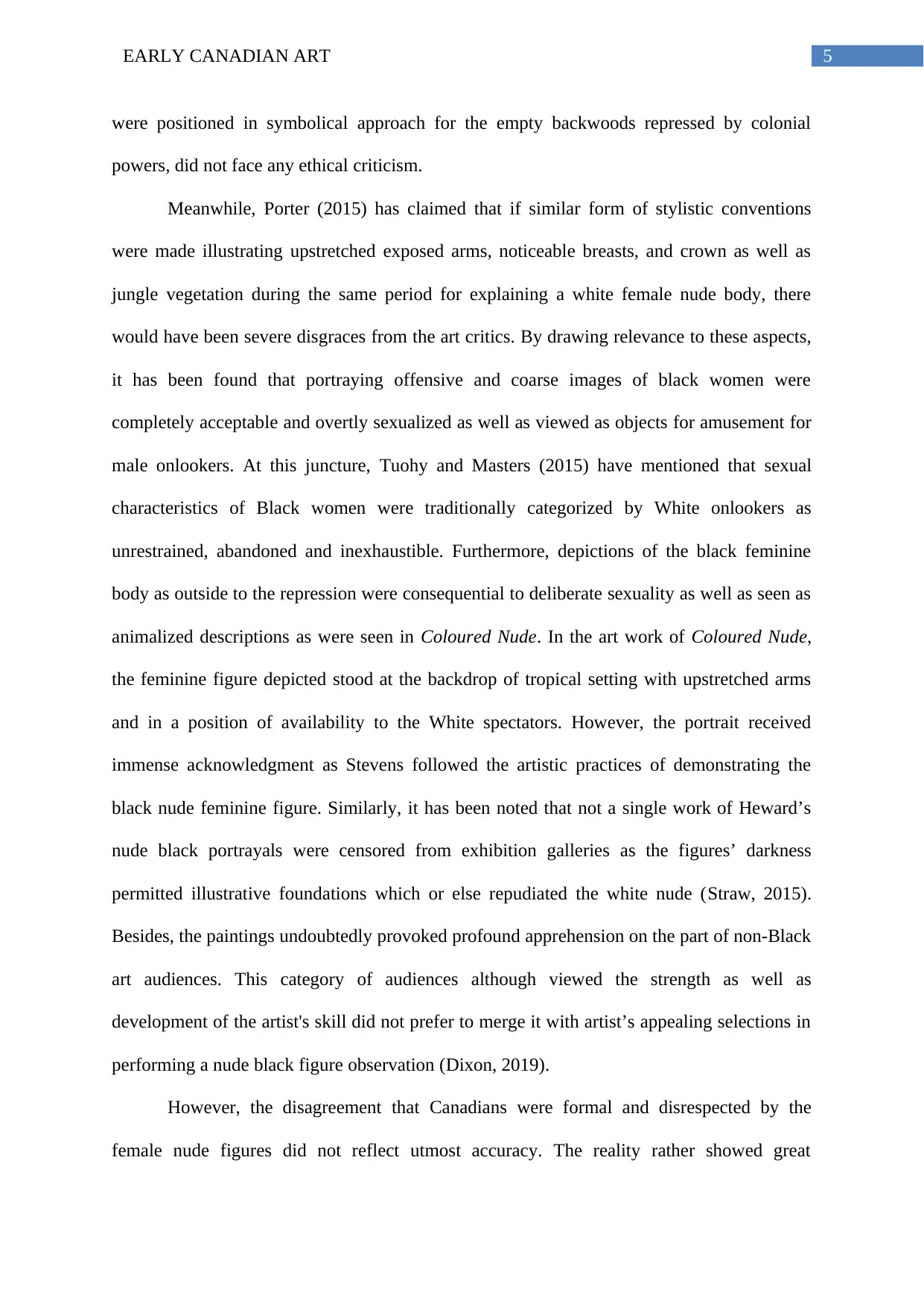
5EARLY CANADIAN ART
were positioned in symbolical approach for the empty backwoods repressed by colonial
powers, did not face any ethical criticism.
Meanwhile, Porter (2015) has claimed that if similar form of stylistic conventions
were made illustrating upstretched exposed arms, noticeable breasts, and crown as well as
jungle vegetation during the same period for explaining a white female nude body, there
would have been severe disgraces from the art critics. By drawing relevance to these aspects,
it has been found that portraying offensive and coarse images of black women were
completely acceptable and overtly sexualized as well as viewed as objects for amusement for
male onlookers. At this juncture, Tuohy and Masters (2015) have mentioned that sexual
characteristics of Black women were traditionally categorized by White onlookers as
unrestrained, abandoned and inexhaustible. Furthermore, depictions of the black feminine
body as outside to the repression were consequential to deliberate sexuality as well as seen as
animalized descriptions as were seen in Coloured Nude. In the art work of Coloured Nude,
the feminine figure depicted stood at the backdrop of tropical setting with upstretched arms
and in a position of availability to the White spectators. However, the portrait received
immense acknowledgment as Stevens followed the artistic practices of demonstrating the
black nude feminine figure. Similarly, it has been noted that not a single work of Heward’s
nude black portrayals were censored from exhibition galleries as the figures’ darkness
permitted illustrative foundations which or else repudiated the white nude (Straw, 2015).
Besides, the paintings undoubtedly provoked profound apprehension on the part of non-Black
art audiences. This category of audiences although viewed the strength as well as
development of the artist's skill did not prefer to merge it with artist’s appealing selections in
performing a nude black figure observation (Dixon, 2019).
However, the disagreement that Canadians were formal and disrespected by the
female nude figures did not reflect utmost accuracy. The reality rather showed great
were positioned in symbolical approach for the empty backwoods repressed by colonial
powers, did not face any ethical criticism.
Meanwhile, Porter (2015) has claimed that if similar form of stylistic conventions
were made illustrating upstretched exposed arms, noticeable breasts, and crown as well as
jungle vegetation during the same period for explaining a white female nude body, there
would have been severe disgraces from the art critics. By drawing relevance to these aspects,
it has been found that portraying offensive and coarse images of black women were
completely acceptable and overtly sexualized as well as viewed as objects for amusement for
male onlookers. At this juncture, Tuohy and Masters (2015) have mentioned that sexual
characteristics of Black women were traditionally categorized by White onlookers as
unrestrained, abandoned and inexhaustible. Furthermore, depictions of the black feminine
body as outside to the repression were consequential to deliberate sexuality as well as seen as
animalized descriptions as were seen in Coloured Nude. In the art work of Coloured Nude,
the feminine figure depicted stood at the backdrop of tropical setting with upstretched arms
and in a position of availability to the White spectators. However, the portrait received
immense acknowledgment as Stevens followed the artistic practices of demonstrating the
black nude feminine figure. Similarly, it has been noted that not a single work of Heward’s
nude black portrayals were censored from exhibition galleries as the figures’ darkness
permitted illustrative foundations which or else repudiated the white nude (Straw, 2015).
Besides, the paintings undoubtedly provoked profound apprehension on the part of non-Black
art audiences. This category of audiences although viewed the strength as well as
development of the artist's skill did not prefer to merge it with artist’s appealing selections in
performing a nude black figure observation (Dixon, 2019).
However, the disagreement that Canadians were formal and disrespected by the
female nude figures did not reflect utmost accuracy. The reality rather showed great
⊘ This is a preview!⊘
Do you want full access?
Subscribe today to unlock all pages.

Trusted by 1+ million students worldwide
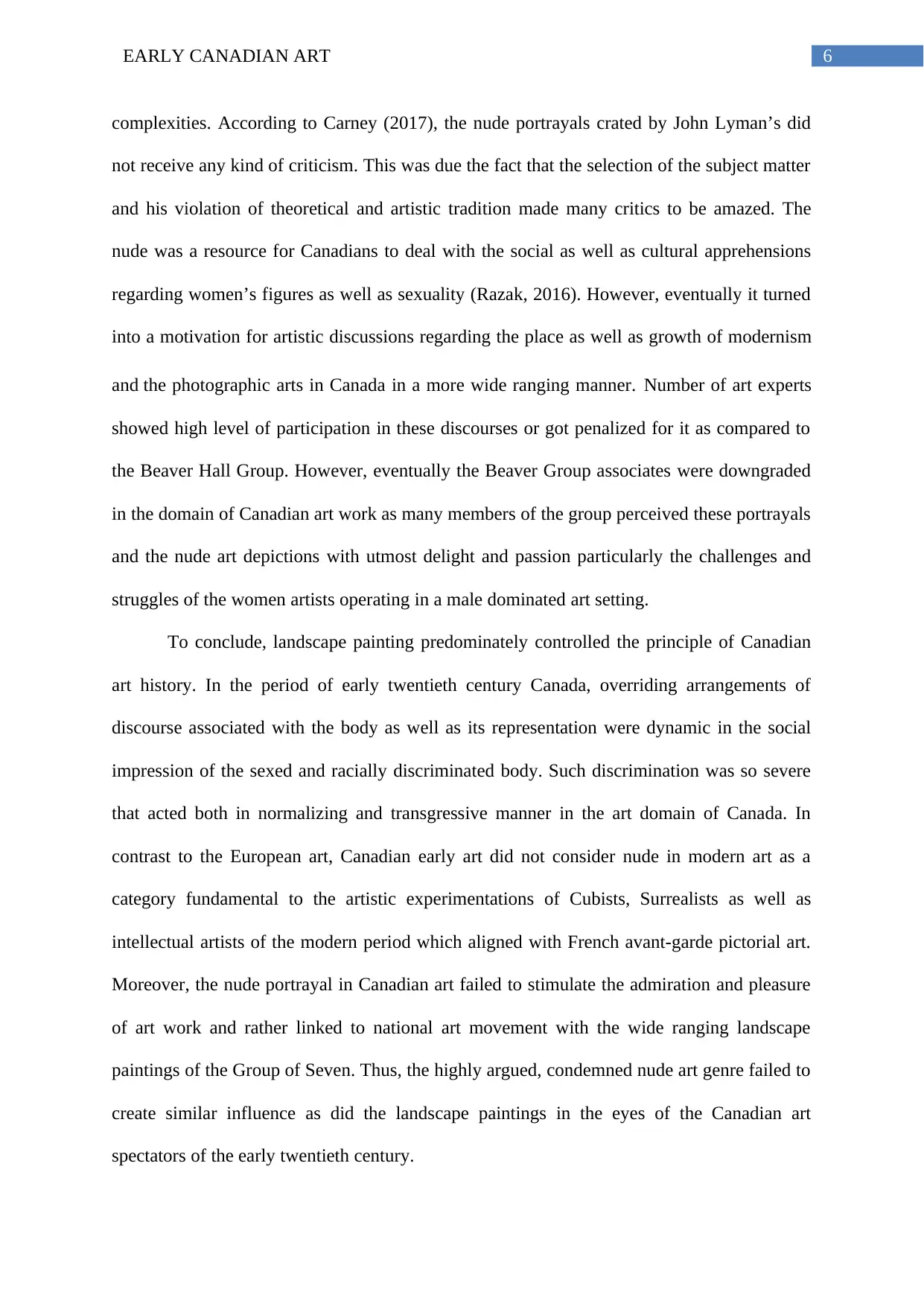
6EARLY CANADIAN ART
complexities. According to Carney (2017), the nude portrayals crated by John Lyman’s did
not receive any kind of criticism. This was due the fact that the selection of the subject matter
and his violation of theoretical and artistic tradition made many critics to be amazed. The
nude was a resource for Canadians to deal with the social as well as cultural apprehensions
regarding women’s figures as well as sexuality (Razak, 2016). However, eventually it turned
into a motivation for artistic discussions regarding the place as well as growth of modernism
and the photographic arts in Canada in a more wide ranging manner. Number of art experts
showed high level of participation in these discourses or got penalized for it as compared to
the Beaver Hall Group. However, eventually the Beaver Group associates were downgraded
in the domain of Canadian art work as many members of the group perceived these portrayals
and the nude art depictions with utmost delight and passion particularly the challenges and
struggles of the women artists operating in a male dominated art setting.
To conclude, landscape painting predominately controlled the principle of Canadian
art history. In the period of early twentieth century Canada, overriding arrangements of
discourse associated with the body as well as its representation were dynamic in the social
impression of the sexed and racially discriminated body. Such discrimination was so severe
that acted both in normalizing and transgressive manner in the art domain of Canada. In
contrast to the European art, Canadian early art did not consider nude in modern art as a
category fundamental to the artistic experimentations of Cubists, Surrealists as well as
intellectual artists of the modern period which aligned with French avant-garde pictorial art.
Moreover, the nude portrayal in Canadian art failed to stimulate the admiration and pleasure
of art work and rather linked to national art movement with the wide ranging landscape
paintings of the Group of Seven. Thus, the highly argued, condemned nude art genre failed to
create similar influence as did the landscape paintings in the eyes of the Canadian art
spectators of the early twentieth century.
complexities. According to Carney (2017), the nude portrayals crated by John Lyman’s did
not receive any kind of criticism. This was due the fact that the selection of the subject matter
and his violation of theoretical and artistic tradition made many critics to be amazed. The
nude was a resource for Canadians to deal with the social as well as cultural apprehensions
regarding women’s figures as well as sexuality (Razak, 2016). However, eventually it turned
into a motivation for artistic discussions regarding the place as well as growth of modernism
and the photographic arts in Canada in a more wide ranging manner. Number of art experts
showed high level of participation in these discourses or got penalized for it as compared to
the Beaver Hall Group. However, eventually the Beaver Group associates were downgraded
in the domain of Canadian art work as many members of the group perceived these portrayals
and the nude art depictions with utmost delight and passion particularly the challenges and
struggles of the women artists operating in a male dominated art setting.
To conclude, landscape painting predominately controlled the principle of Canadian
art history. In the period of early twentieth century Canada, overriding arrangements of
discourse associated with the body as well as its representation were dynamic in the social
impression of the sexed and racially discriminated body. Such discrimination was so severe
that acted both in normalizing and transgressive manner in the art domain of Canada. In
contrast to the European art, Canadian early art did not consider nude in modern art as a
category fundamental to the artistic experimentations of Cubists, Surrealists as well as
intellectual artists of the modern period which aligned with French avant-garde pictorial art.
Moreover, the nude portrayal in Canadian art failed to stimulate the admiration and pleasure
of art work and rather linked to national art movement with the wide ranging landscape
paintings of the Group of Seven. Thus, the highly argued, condemned nude art genre failed to
create similar influence as did the landscape paintings in the eyes of the Canadian art
spectators of the early twentieth century.
Paraphrase This Document
Need a fresh take? Get an instant paraphrase of this document with our AI Paraphraser
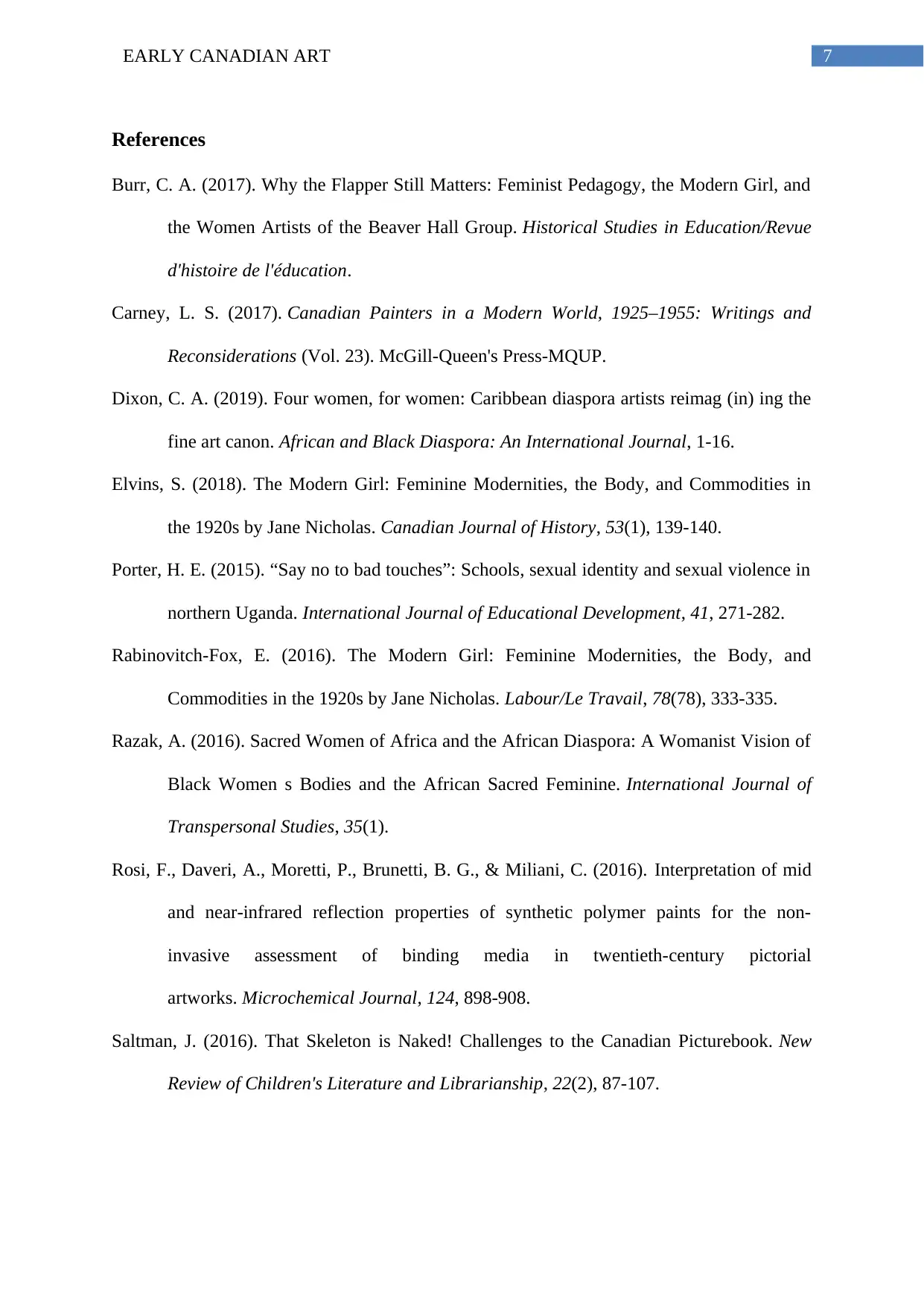
7EARLY CANADIAN ART
References
Burr, C. A. (2017). Why the Flapper Still Matters: Feminist Pedagogy, the Modern Girl, and
the Women Artists of the Beaver Hall Group. Historical Studies in Education/Revue
d'histoire de l'éducation.
Carney, L. S. (2017). Canadian Painters in a Modern World, 1925–1955: Writings and
Reconsiderations (Vol. 23). McGill-Queen's Press-MQUP.
Dixon, C. A. (2019). Four women, for women: Caribbean diaspora artists reimag (in) ing the
fine art canon. African and Black Diaspora: An International Journal, 1-16.
Elvins, S. (2018). The Modern Girl: Feminine Modernities, the Body, and Commodities in
the 1920s by Jane Nicholas. Canadian Journal of History, 53(1), 139-140.
Porter, H. E. (2015). “Say no to bad touches”: Schools, sexual identity and sexual violence in
northern Uganda. International Journal of Educational Development, 41, 271-282.
Rabinovitch-Fox, E. (2016). The Modern Girl: Feminine Modernities, the Body, and
Commodities in the 1920s by Jane Nicholas. Labour/Le Travail, 78(78), 333-335.
Razak, A. (2016). Sacred Women of Africa and the African Diaspora: A Womanist Vision of
Black Women s Bodies and the African Sacred Feminine. International Journal of
Transpersonal Studies, 35(1).
Rosi, F., Daveri, A., Moretti, P., Brunetti, B. G., & Miliani, C. (2016). Interpretation of mid
and near-infrared reflection properties of synthetic polymer paints for the non-
invasive assessment of binding media in twentieth-century pictorial
artworks. Microchemical Journal, 124, 898-908.
Saltman, J. (2016). That Skeleton is Naked! Challenges to the Canadian Picturebook. New
Review of Children's Literature and Librarianship, 22(2), 87-107.
References
Burr, C. A. (2017). Why the Flapper Still Matters: Feminist Pedagogy, the Modern Girl, and
the Women Artists of the Beaver Hall Group. Historical Studies in Education/Revue
d'histoire de l'éducation.
Carney, L. S. (2017). Canadian Painters in a Modern World, 1925–1955: Writings and
Reconsiderations (Vol. 23). McGill-Queen's Press-MQUP.
Dixon, C. A. (2019). Four women, for women: Caribbean diaspora artists reimag (in) ing the
fine art canon. African and Black Diaspora: An International Journal, 1-16.
Elvins, S. (2018). The Modern Girl: Feminine Modernities, the Body, and Commodities in
the 1920s by Jane Nicholas. Canadian Journal of History, 53(1), 139-140.
Porter, H. E. (2015). “Say no to bad touches”: Schools, sexual identity and sexual violence in
northern Uganda. International Journal of Educational Development, 41, 271-282.
Rabinovitch-Fox, E. (2016). The Modern Girl: Feminine Modernities, the Body, and
Commodities in the 1920s by Jane Nicholas. Labour/Le Travail, 78(78), 333-335.
Razak, A. (2016). Sacred Women of Africa and the African Diaspora: A Womanist Vision of
Black Women s Bodies and the African Sacred Feminine. International Journal of
Transpersonal Studies, 35(1).
Rosi, F., Daveri, A., Moretti, P., Brunetti, B. G., & Miliani, C. (2016). Interpretation of mid
and near-infrared reflection properties of synthetic polymer paints for the non-
invasive assessment of binding media in twentieth-century pictorial
artworks. Microchemical Journal, 124, 898-908.
Saltman, J. (2016). That Skeleton is Naked! Challenges to the Canadian Picturebook. New
Review of Children's Literature and Librarianship, 22(2), 87-107.
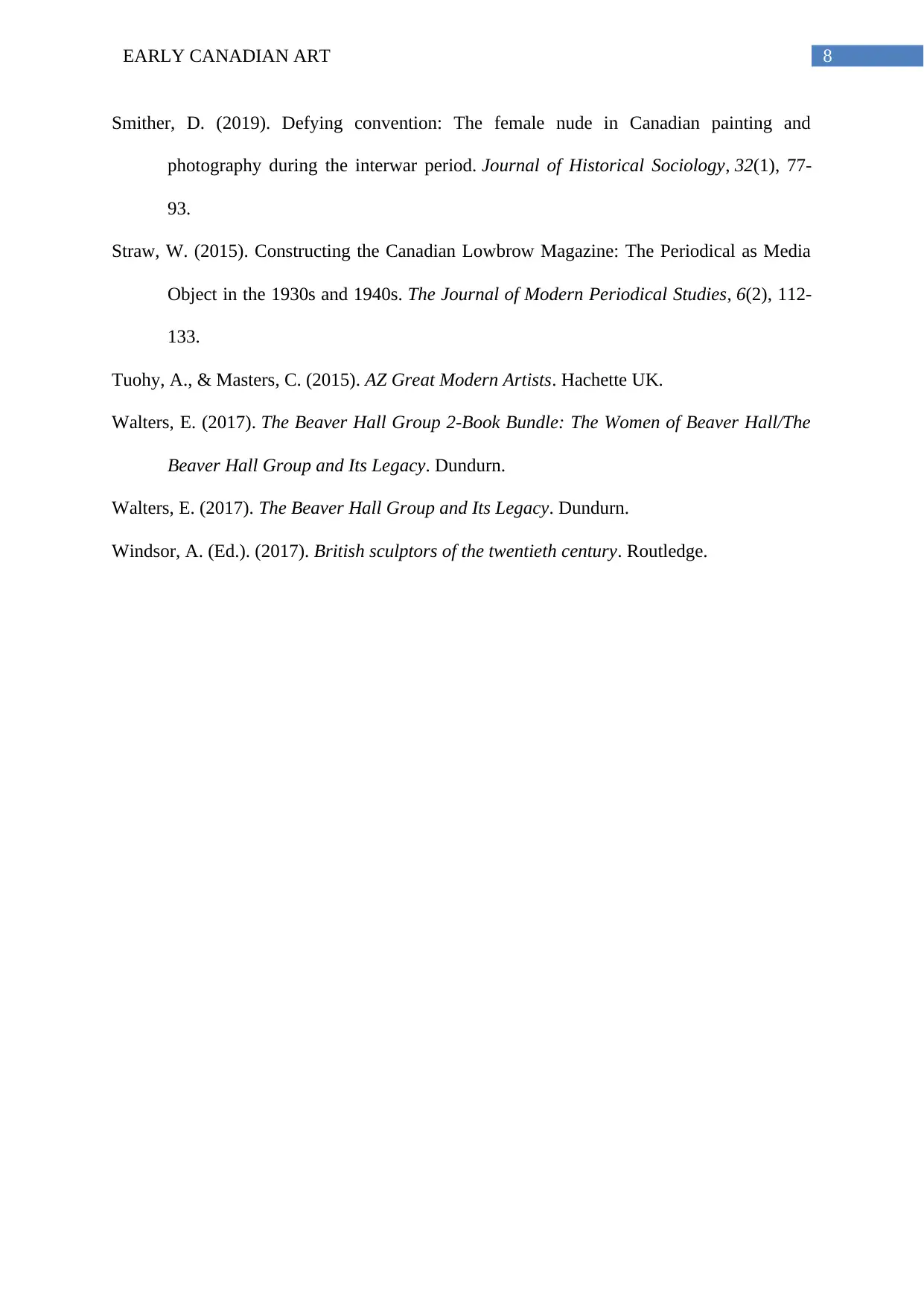
8EARLY CANADIAN ART
Smither, D. (2019). Defying convention: The female nude in Canadian painting and
photography during the interwar period. Journal of Historical Sociology, 32(1), 77-
93.
Straw, W. (2015). Constructing the Canadian Lowbrow Magazine: The Periodical as Media
Object in the 1930s and 1940s. The Journal of Modern Periodical Studies, 6(2), 112-
133.
Tuohy, A., & Masters, C. (2015). AZ Great Modern Artists. Hachette UK.
Walters, E. (2017). The Beaver Hall Group 2-Book Bundle: The Women of Beaver Hall/The
Beaver Hall Group and Its Legacy. Dundurn.
Walters, E. (2017). The Beaver Hall Group and Its Legacy. Dundurn.
Windsor, A. (Ed.). (2017). British sculptors of the twentieth century. Routledge.
Smither, D. (2019). Defying convention: The female nude in Canadian painting and
photography during the interwar period. Journal of Historical Sociology, 32(1), 77-
93.
Straw, W. (2015). Constructing the Canadian Lowbrow Magazine: The Periodical as Media
Object in the 1930s and 1940s. The Journal of Modern Periodical Studies, 6(2), 112-
133.
Tuohy, A., & Masters, C. (2015). AZ Great Modern Artists. Hachette UK.
Walters, E. (2017). The Beaver Hall Group 2-Book Bundle: The Women of Beaver Hall/The
Beaver Hall Group and Its Legacy. Dundurn.
Walters, E. (2017). The Beaver Hall Group and Its Legacy. Dundurn.
Windsor, A. (Ed.). (2017). British sculptors of the twentieth century. Routledge.
⊘ This is a preview!⊘
Do you want full access?
Subscribe today to unlock all pages.

Trusted by 1+ million students worldwide
1 out of 9
Your All-in-One AI-Powered Toolkit for Academic Success.
+13062052269
info@desklib.com
Available 24*7 on WhatsApp / Email
![[object Object]](/_next/static/media/star-bottom.7253800d.svg)
Unlock your academic potential
Copyright © 2020–2025 A2Z Services. All Rights Reserved. Developed and managed by ZUCOL.

